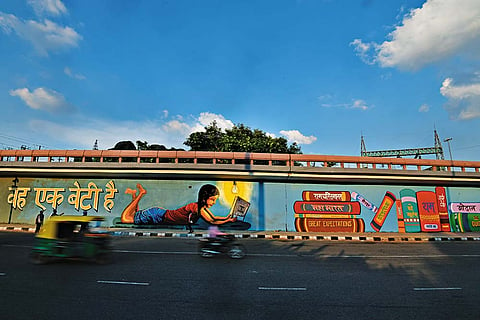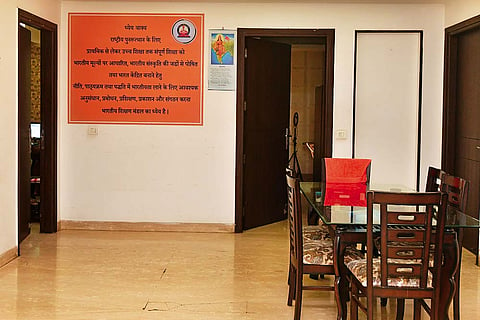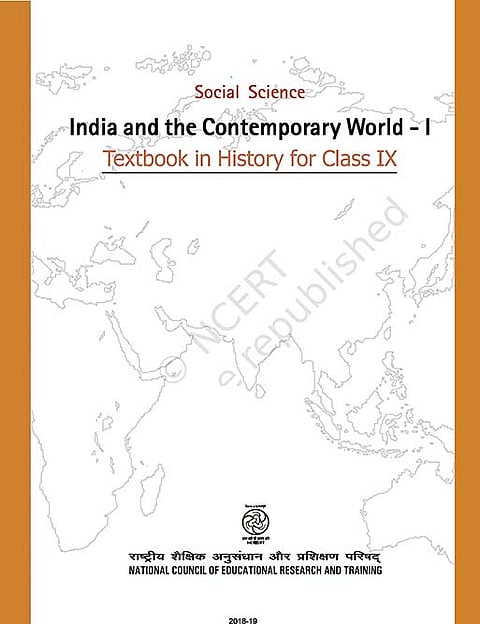“The answer is silence. About that there are many tales,
many books in press. Best not to believe everything.
How many killed in six years’ confrontation?
The answer is silence.”
Future Of Education: Are Curriculum Changes Politically Motivated?
Should curricula not reflect the ‘truth’? And whose truth? Recent deletions and additions come wrapped in a concern for ‘heritage’, but are also dyed in a deep disquiet over other zones of contestation—caste and gender—beyond religion.
—Mahasweta Devi, Draupadi (translated by Gayatri Chakravorty Spivak)
The University of Delhi has removed Draupadi from the English syllabus. The late Mahasweta Devi’s 1977 short story titled after the character from the Mahabharata features Dopdi, a Santhal woman who takes on the State’s armed might and refuses to let her violated body be covered up after being raped repeatedly in custody. The sight of her naked, bleeding body sends shivers down the spine of the military commander. It’s a powerful image of the female body as a site of resistance rather than vulnerability. And it also evokes a feminist reading of the Mahabharata’s Draupadi that gives her a central place in the epic—anchored in the tale of Draupadi avenging her humiliation by the Kauravas at the Hastinapur court. The DU oversight committee’s decision to drop Mahasweta Devi’s story from the semester-5 syllabus is thus an intervention in how women, especially women from oppressed communities, are represented in literature. According to oversight committee head M.K. Pandit, the “gory description of the private parts of a woman” has no place in a class that has students from diverse social backgrounds. “What people read and discuss in private is one thing and what is appropriate in public quite another,” he adds.
The committee also dropped Dalit writer Bama, whose autobiographical novel Karukku chronicles the lives of Dalit Christian women in Tamil Nadu, and Tamil Dalit feminist poet Sukirtharani. In their note of dissent, 15 members of the university’s academic council called the move an act of “maximum vandalism” and accused the oversight committee of “prejudice against the representation of Dalits, tribals, women and sexual minorities, as evident from its concerted efforts to remove all such voices from the syllabus”. Among those defending the dropping of Draupadi is IGNOU professor of education C.B. Sharma, who was chairman of the National Institute of Open Schooling from 2015 to 2020. “Do we prescribe things that say we are such a bad country, that we are such a bad people, that we are oppressors? Do we teach this?” asks Sharma, who believes Mahasweta Devi’s story is a reaction to an “aberration” in Indian society. Insisting that the society is “not primarily oppressive”, he says writers may react to aberrations, but “you don’t prescribe that in the curriculum with the seal of the government or the university on it”.
The DU row over what deserves to be in the curriculum and what doesn’t is just the tip of the iceberg. In March, the University Grants Commission (UGC) came out with the draft of a history syllabus for undergraduates—Learning Outcomes-based Curriculum Framework for BA in history—that emphasises Hindu mythology and religious texts, while reducing the study of Muslim rulers. Recently, the Kerala government was in the eye of a storm over inclusion of extracts from We or Our Nationhood Defined by the RSS’s second sarsanghchalak M.S. Golwalkar and Who Is a Hindu? by Hindutva ideologue V.D. Savarkar in the syllabus of Kannur University. While Congress student wing NSUI protested “saffronisation” by the CPI(M)-led government, state education minister R. Bindu asked vice-chancellor Gopinath Raveendran to explain the inclusion. Later, the V-C announced that both the extracts have been dropped from the curriculum.
Deletions from syllabi have also generated heat in other parts of the country. In Bihar, there was an outcry over socialists Jayaprakash Narayan and Ram Manohar Lohia being dropped from the MA political science syllabus at JP University in Chhapra (Saran). In Uttar Pradesh, writings of Rabindranath Tagore and former President S. Radhakrishnan will no longer be on the Class 12 reading list. Last year, Maharashtra removed topics like farmers’ suicides, unemployment and workers’ movements from the Class 12 syllabus for sociology.
On July 7, 2020, then Union education minister Ramesh Pokhriyal Nishank announced that he had advised the CBSE to reduce the course load for students of classes 9 to 12 because of the extraordinary situation prevailing during the pandemic. The result: chapters on secularism, federalism, gender, caste and religion were removed from the exam syllabus, along with those on the functioning of the human eye, the cleaning capacity of soap in hard and soft water, practical experiments like tests with acetic acid etc. They would, however, be retained as concepts to be taught. The CBSE said rationalisation of syllabus to the extent of 30 per cent was being done for nearly 190 subjects from classes 9 to 12 for 2020-21 as a one-time measure to reduce the burden on students during the pandemic.

Ramcharitmanas and the Mahabharata are the first two books featured in this street art on educating the girl child
The Blueprint
Tucked away on the second floor of a building close to a small Hanuman temple in Amrit Nagar near Delhi’s South Extension-1 is the office of the Bharatiya Shikshan Mandal, an RSS affiliate in the sphere of education. Inside, an empty chair marks the reception area and, above it, on the freshly painted wall, are three portraits: besides those of RSS founder K.B. Hedgewar and Golwalkar, there is one of ‘Bharat Mata’ sitting on a lion, with the map of ‘Akhand Bharat’ wrapped around her like a saffron sari. A rectangular saffron-coloured board on the opposite wall spells out the Mandal’s mission in Sanskritised Hindi. Translated in English, it roughly says that the Mandal aims to “Indianise” educational policy, curriculum and pedagogy, in order to infuse education, from primary to higher levels, with “Indian values” for the sake of “national regeneration”, and to ensure it is nurtured by “Indian culture” and centred on “Indian interests”.
This agenda finds resonance in UGC’s draft history syllabus, in which the first paper is on the ‘Idea of Bharat’, with pride of place given to the Vedas, Upanishads, Smritis and Puranas. The Mandal’s all-India joint organising secretary B.R. Shankarananda cites “national interest” as a strong reason for changes in curricula and deletions from textbooks. And the UGC syllabus gives a clue to what he could possibly mean by the phrase. The sections under ‘Idea of Bharat’ suggest a desire to establish the existence of what the introduction to the syllabus calls the “nation’s soul”. In the third paper, ‘From Earliest Times to 550 CE’, the Harappan civilisation is called ‘Indus-Saraswati civilisation’, a conflation clearly meant to establish continuity with the later historical periods in contrast with theories of Aryan invasion and its later variant, Aryan migration. The idea can be traced to the works of archaeologists like B.B. Lal and S.P. Gupta, who sought to find linkages between Harappan culture and the Saraswati river of the Rig Veda.
The Ramayana and the Mahabharata are specially treated under a separate head—‘Tradition of Cultural Heritage’—while only one paper is devoted to the period from the 13th century to the 18th, the time of Muslim dynasties, including the Mughals. There is more emphasis on the Mewar and Maratha resistance against the Mughals. Akbar is not mentioned in the curriculum, though the prescribed books do give space to the Mughal emperor. Babar’s reign is depicted as an“invasion”. Moreover, “Hindu society” and “Muslim society” in medieval India are dealt with as separate topics—as if each can be studied in isolation from the other. The category ‘communalism’, which historian Gyan Pandey has argued was constructed in the 1920s to denounce politics based on religious community, has been retained in the context of the 1942-47 period, leading up to Partition.
A perusal of the curriculum makes it clear that what lies at the heart of the controversy is the revival of a decades-old battle for the past. While historians have written pieces in the popular media questioning its professional competence, the reading lists also show a more thought-out shift. If university syllabi over the last few decades had books by scholars who were either Marxist or broadly aligned with the left—D.D. Kosambi, R.S. Sharma, D.N. Jha, Romila Thapar, Irfan Habib, Satish Chandra, Bipan Chandra and Sumit Sarkar were routinely taught in universities like JNU and DU—the new curriculum marks the return of scholars like R.C. Majumdar, Jadunath Sarkar, R.S. Tripathi, Aashirwadi Lal Srivastav and K.A. Nilakantha Sastri. The move away from Marxist readings is clear, though Thapar, Bipan Chandra and Sarkar do find a mention in the new reading list.
Expunging a Rebellion
In 2019, the National Council for Educational Research and Training deleted a chapter on the Shanar revolt (1813-59), or the upper cloth movement, led by Nadar women, from a Class 9 history textbook used in CBSE schools. In 19th-century Travancore, women from underprivileged castes like Shanar (later Nadar) were not allowed to cover their upper bodies, among several other caste-based restrictions—as part of a formal protocol of humiliation imposed by the dominant castes. A ‘breast tax’ was imposed on those who defied the diktat. What began as a fight for women’s dignity took on more layers with the community refusing to do free labour for elite-caste landlords, and became a full-blown rebellion against caste oppression. Reprisals were brutal. Dominant-caste men, enraged by the defiance of Nadar women, attacked them and stripped them of the tailored blouses they had started wearing from 1820. The court of Travancore, which had in 1829 decreed that Nadar women shouldn’t cover their breasts, was eventually forced in 1859 to permit them to wear a jacket like what Syrian Christian women wore and cover their upper bodies—but “not like the women of high caste”.

Agenda Lines on a board at the Bharatiya Shikshan Mandal office spell out the RSS vision of education
The revolt is discussed in the chapter titled Clothing: A Social History, penned by historian Janaki Nair, in the Class 9 textbook India and the Contemporary World-I. It was expunged from the textbook in a ‘curriculum rationalisation’ exercise meant to reduce the burden on students. The rationalisation was itself rationalised: a source in the human resource development ministry cited “representations from about 1,200 school teachers who wanted portions deleted”. “We did nothing on our own but showed sensitivity to their experience in school teaching,” adds the source.
According to Shankarananda, curricula at all levels should be constantly reviewed to ensure “holistic development of the individual in line with Indian thought”. School textbooks, in particular, should not just be based on truth, but the truth must be based on “national interest”, he insists. For example, he adds, it is fine at senior levels of research to condemn a disability imposed on a social group in the past—but “in school textbooks, it is important to understand the impact of what is written on young minds”. “School children need not be exposed to past conflicts that can make them prejudiced at a young age,” says Shankarananda.
A senior historian closely associated with textbook writing disagrees. “Even the curriculum of school textbooks isn’t frozen over time. When I was in school, we read colonial histories offering details about governors-general. By the time you were in school, these had been replaced by histories that traced the coming of nationalism, Gandhian movements etc,” he says.
In the backdrop were also protests by political parties in Tamil Nadu, including both the DMK and the AIADMK, seeking deletion of “objectionable references” in the chapter—the description of the Shanars (Nadars) as a community of toddy tappers who migrated to south Travancore. Both J. Jayalalithaa and M. Karunanidhi wrote to the PM saying Nadars were original inhabitants of the region and not a “lower caste” as claimed in the book.
How did a simple narrative of oppression and revolt end up getting framed in terms of caste insult itself? “Historically, some upwardly mobile castes tend to erase memories of past degradation and see any reference to it as an attempt to insult the community,” explains Anirban Bandyodadhyay, a scholar of caste.

Three chapters were deleted from this NCERT history textbook for Class 9 students
Earlier, in 2016, following a Madras High Court directive, the CBSE decided to remove the section titled Caste, Conflict and Dress Change from the Class 9 curriculum. The board said no question from the section should be asked in the 2017 examination, though it remained in the textbook until it was removed when the curriculum was revised in 2018-19. Media reports put the deletions from India and the Contemporary World-1 at about 70 pages of text and illustrations—three chapters, including the one authored by Janaki Nair.
“There were concerns expressed by Hindu Nadars and we tried to engage them. However, Christian Nadars wanted the section to stay,” says a scholar who worked on the history textbooks. Another scholar involved in the textbook writing process says there was a lot of to-and-fro of the authors with the NCERT, but they were not taken on board when the sections were finally omitted. “I don’t mind if the books are replaced by new ones. But deletions, alterations and omissions pose a problem, as they will in future make me appear to have authored what I did not,” says the scholar.
Rewriting Caste
The row over the depiction of the Shanar revolt is also an opening into conversations over the place, rather absence, in school curricula of the history and literature of the oppressed castes, especially from a Dalit perspective. “Omissions are never desirable because often it is the historically marginalised communities and people who get omitted. Majoritarian history can hardly count as the history of a country,” says historian Aparna Vaidik, who teaches at Ashoka University. Sociologist Vivek Kumar believes our textbooks hardly represent Dalit voices. “The National Curriculum Framework did address the caste question and included icons like Babasaheb Ambedkar and Jyotiba Phule. However, till now I don’t see a change where Dalits are being asked to narrate their own versions of reality,” says Kumar, who feels we need more Dalit scholars, artistes and writers in decision-making positions. “They must be allowed to represent their society. And this representation has to go beyond icons,” he adds. According to Kumar, the entire repertoire of Dalit lives—literature, songs, women, diaspora—should be written about. “It should be not confined to victimhood, but explore their everyday lives and cultures. This will bring diversity to education.”
However, there are innovative ways in which Dalit organisations are plugging the gaps. For instance, the Bhim Army led by Chandrashekhar Azad ‘Ravan’ has set up more than 1,000 Bhim Pathshalas (schools) in Uttar Pradesh. These initially began as post-school, two-hour coaching classes in Saharanpur, but gradually expanded in scope. Functioning mainly from the homes of members of the Bhim Army, community halls and panchayat offices, these schools, which were open until the pandemic lockdowns, provided free classes not just in regular subjects like science or math, but also educated children about Dalit perspectives on history, foregrounding the lived realities of the oppressed, their struggles against oppression and their visions of a more equitable society. Members of the Bhim Army also contributed resources for the functioning of these schools, trying to make them part of the community’s self-organised efforts to emancipate itself by transforming the larger society. The production and dissemination of knowledge from the grassroots that such projects can enable may well be outside the formal spaces demarcated by school and university curricula. But there is no telling when, how and how much they could eventually influence perceptions of what should be studied and in what manner.
(This appeared in the print edition as "Go Get Educat")
(With inputs from Lola Nayar)